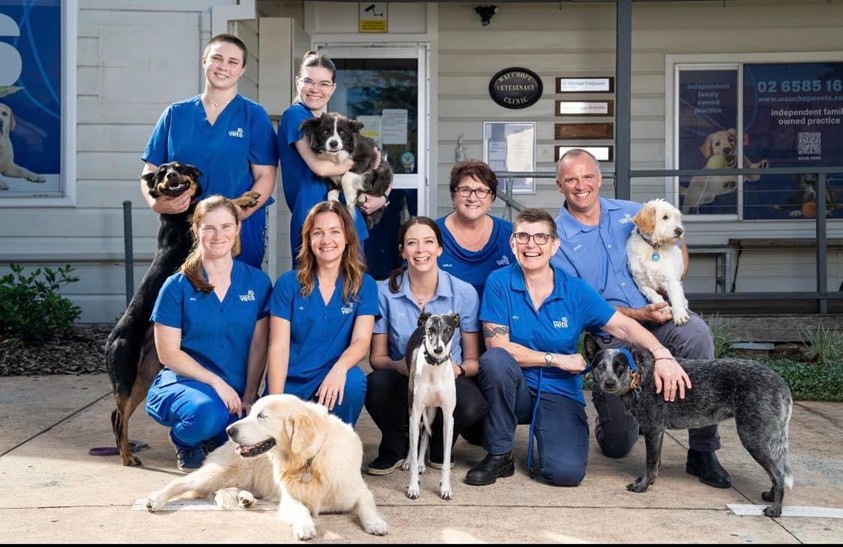After-Hours Services Models

Photo supplied with permission Wauchope Veterinary Clinic team.
The ongoing challenges surrounding emergency and after-hours (ER-AHs) veterinary care are a global concern, and we have the opportunity to learn from New Zealand's recent in-depth review of the delivery of ER-AHs services. This review, grounded in systems thinking, identified six key dynamics that influence the delivery of emergency after-hours veterinary care in New Zealand. We believe these findings are highly relevant to the Australian veterinary landscape, despite some contextual differences such as geographical spread and industry sectors.
Six Key Dynamics from the NZ review
- Veterinarians’ confidence, proficiency & willingness to do emergency shifts. The review highlighted the importance of veterinarians’ confidence and proficiency in performing emergency care, along with their willingness to participate in ER-AHs rosters. A balanced frequency of shifts is vital to support veterinarians' wellbeing and maintain service quality.
- Client circumstances & expectations
Client expectations, such as timely care and perceived urgency of cases, place significant pressure on veterinarians. Managing these expectations is essential to prevent burnout and ensure realistic client understanding of after-hours services. - Financial considerations
Financial challenges, including client willingness to pay and the financial viability of after-hours services, were highlighted as critical. Pet insurance plays a role in improving financial security for both veterinarians and clients, reducing tensions over fee discounting. - Medical knowledge & training
The increasing demand for advanced medical care during after-hours shifts requires ongoing professional development and mentoring, particularly in non-technical areas like client communication and business management. The role of academic institutions in preparing graduates is also a contributing factor. - Veterinarian professional development in practices
Effective mentoring and on-the-job training are necessary to maintain high standards of care and veterinary confidence, especially when dealing with the complexities of after-hours services. The development of necessary business skills was also highlighted. - Veterinarian stimulation in work, wellbeing & job satisfaction
Job satisfaction and wellbeing are strongly linked to the stimulation veterinarians receive from their work, as well as their remuneration, and support systems in place to mitigate the stresses of after-hours and emergency work.
The full NZ report can be found here.
Relevance to the Australian veterinary setting
Feedback from AVA members indicates that the dynamics outlined in the NZ project are applicable to the Australian context. While the specific demands of farm work and geographical distances differ, the core issues of burnout, financial strain, and managing client expectations resonate strongly with Australian practices. The seasonal nature of farm production work in both countries adds unique pressures, with Australian regional vets particularly impacted by long travel times between calls, further contributing to fatigue and reducing financial return.
Case examples of Australian practices
Several Australian practices are already addressing these dynamics successfully through after-hours sharing mechanisms.
The Coffs Harbour region in NSW implemented a combined after-hours service where participating clinics share the after-hours load. This arrangement has been in place since 2010 and has helped ensure that all veterinarians in the district benefit from greater leisure time while maintaining high service standards.
Based off the Coffs Harbour model, a regional NSW mixed practice (photo below) also developed a sharing model for after-hours services. By collaborating with nearby clinics, they managed to alleviate the pressure of after-hours work, creating a culture of cooperative competition and mutual support. This model has resulted in significant improvements in work-life balance and service delivery, demonstrating the potential for inter-practice collaboration.
The majority of practices in the Darwin area also share an after-hours roster with similarly significant positive benefits to all practices and veterinarians who participate.
A template based on the Coffs Harbour Combined Veterinary After-Hours Service model can be found here.
Screenshot from the After-Hours Shared Services Model Template
Safety risk mitigation strategies
In 2023, on the initiative of the NT AVA Division, NT practices were surveyed around their safety concerns for staff providing after-hours services. As a result of that work, some helpful safety risk mitigation strategies were compiled and can be found here.
Call for input
As we continue to explore solutions for the sustainability of ER-AHs services in Australia, we invite members to share their experiences and strategies. If your practice has implemented effective approaches to managing after-hours care, or if you have additional ideas on how we can better support veterinary practice in this space, we welcome hearing from you. Your insights will help us build a stronger, more supportive framework for our profession.
Please send your suggestions or case examples to publicvetaffairs@ava.com.au.

